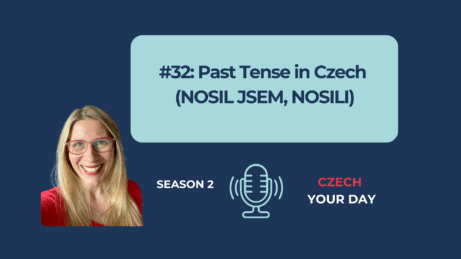Mastering Czech Past Tense: Second Position (S02/E33 – daily podcast CZECH YOUR DAY)

THIS WEEK’S TOPIC: ZIMNÍ OBLEČENÍ/WINTER CLOTHES
THE TRANSCRIPT/HANDOUT IS DOWN BELOW
n our last episode, all sentences began with the verb „NOSIT“ (to wear). But what happens when the sentence starts with a different element? Let’s explore this by checking these examples:
- Nosila jsem sukně a šaty. (I wore skirts and dresses.)
- Já jsem nosila sukně a šaty. (I wore skirts and dresses.)
- Nosil jsem zimní boty. (I wore winter boots.)
- Já jsem nosil zimní boty. (I wore winter boots.)
- Nosil jsi sandále? (Did you wear sandals?)
- Ty jsi nosil sandále? (Did you wear sandals?)
- Nosila kabát a kozačky. (She wore a coat and boots.)
- Ona nosila kabát a kozačky. (She wore a coat and boots.)
- Nosilo každý den čepici. (It wore a cap every day.)
- To dítě nosilo každý den čepici. (The child wore a cap every day.)
- Nosili jsme kabáty a zimní bundy. (We wore coats and winter jackets.)
- My jsme nosili kabáty a zimní bundy. (We wore coats and winter jackets.)
- Nosili jste zimní boty? (Did you wear winter boots?)
- Vy jste nosili zimní boty? (Did you wear winter boots?)
- Nosili rukavice, šály a čepice. (They wore gloves, scarves, and caps.)
- Oni nosili rukavice, šály a čepice. (They wore gloves, scarves, and caps.)
As you can see, there are no changes for third-person singular or plural (he, she, it, and they).
- Nosilo každý den čepici. (It wore a cap every day. – meaning the child – it’s neutral in Czech)
- To dítě nosilo každý den čepici. (The child wore a cap every day.)
Making Adjustments in Sentence Order
In Czech, the verb „to be“ (JSEM, JSI, JSME, JSTE) must find its place in the so-called second position of a sentence. This doesn’t necessarily mean it has to be the second word but rather, within the primary structure. For instance:
- Nosil jsem kalhoty. (I wore trousers. – masculine)
- Já jsem nosil kalhoty. (I wore trousers.)
- V zimě jsem nosil kalhoty. (I wore trousers in winter.)
- Každý den jsem nosil kalhoty. (I wore trousers every day.)
Additional Practice
Here’s a practical bonus for you: always compare the sentences and check the position of JSEM/jSI/JSME/JSTE:
- V létě jsem nosila sukně a kalhoty. (In the summer I wore skirts and trousers.)
- Nosila jsem sukně a šaty. (I wore skirts and dresses.)
- Co jsi nosila na jaře? (What did you wear in the spring?)
- Nosila jsi kalhoty? (Did you wear trousers?)
- My jsme v zimě nosili kabáty a zimní bundy. (We wore coats and winter jackets in the winter.)
- Nosili jsme kabáty a zimní bundy. (We wore coats and winter jackets.)
- Kdy jste nosili sandále? (When did you wear sandals? – asking a group)
- Nosili jste zimní boty? (Did you wear winter boots? – asking a group)
Komentáře








